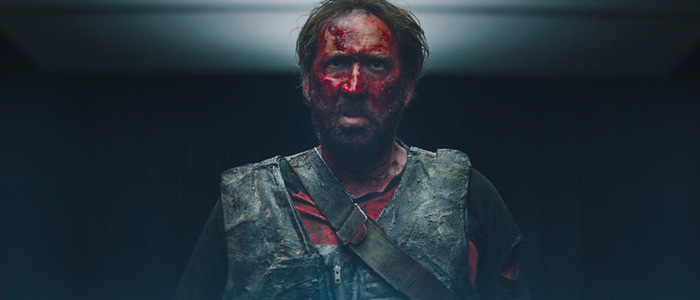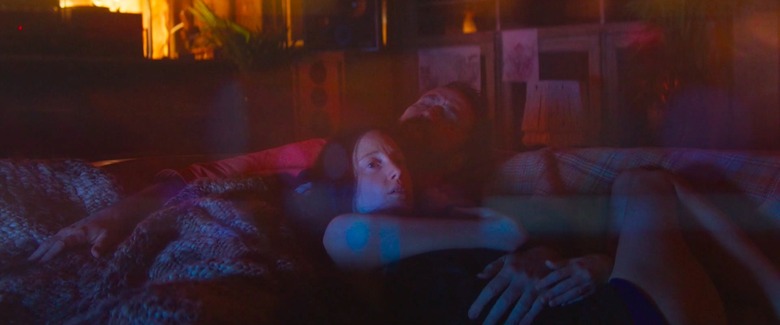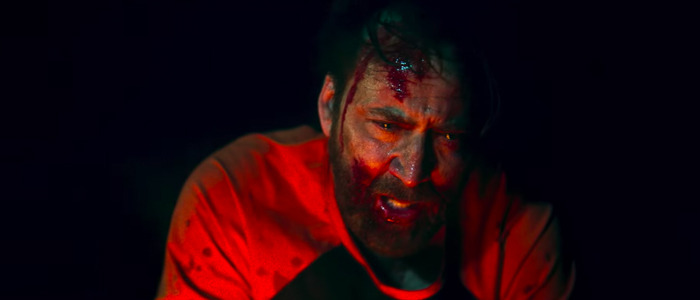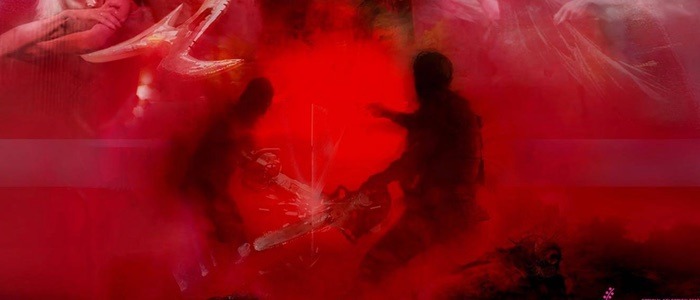'Mandy' Is A Captivating Reconstruction Of The Self – And It Also Has Nicolas Cage Getting In Chainsaw Fights
There are very few filmmakers who can match the energy Nicolas Cage brings to the screen. Werner Herzog is one; his Bad Lieutenant: Port of Call New Orleans, a bad-cop-gone-worse story, pits Cage against his drug-fueled demons and has them breakdance to taunt him. Adaptation, one could argue, traps Cage within creative claustrophobia and makes him force his way out. Perhaps this year's Mom and Dad comes close, allowing Cage to take a sledgehammer to a pool table while singing the Hokey Pokey. But Panos Cosmatos' Mandy, in which Cage does more screaming than speaking, may well be the Holy Grail.
The Nicolas Cage Losing His Shit montage on YouTube is creeping up on a million views, and while it's all too easy to make fun of it, the video also doubles as the show-reel of an actor willing to dive in headfirst unlike most others. Cage creates people that feel like they can't be contained by a screen, and Mandy is the rare film (the only film, perhaps) that approximates what it must be like to live inside the head of one of his characters. It's filled to the brim with melancholy energy, in constant motion even during its quietest moments, stripping away layers of meaning and imagery until it furiously smashes them back together. "Finally," I thought, as Mandy reached its fiery climax, "a film about Nic Cage's specific brand of sadness."
A Familiar Story
To put the film's plot on paper is folly, though I need to do just that for context; it's exactly what you'd expect from a film where a woman, Cage's love, becomes the object of a villain's affection. Deep in the woods in the early '80s, lumberjack Red (Cage) lives with Mandy (Andrea Riseborough) in what feels like an idyllic setting. Their cabin bedroom may as well be at one with nature, separating them from the trees with thin sheets of glass, as they sleep under the night sky. They share a deep camaraderie, one that's jeopardized when Mandy is kidnapped by cult leader Jeremiah Sand (Linus Roache) after which, as you may have gauged from the trailer, fights with axes and chainsaws ensue.
Who exactly is doing the kidnapping, though? Jeremiah has regular henchmen (and henchwomen) who follow him on his mission to re-unite with a Saviour, but for a mission as Holy as acquiring Mandy, he enlists demonic bikers that feel like they've stepped right out of Hell. At first, it seems like Red is up against supernatural powers, for which he fashions a battle-axe that wouldn't feel out of place in a space-set B-movie plucked from the era. The reveal, however, of what's really going on — less a "twist" and more a necessary deflation — sets the story in a whole new context.
The satanic bikers in question are simply a gang of couriers who had a particularly bad acid trip (if anything is "supernatural," it's the strength of the drugs they take) and the cult in question isn't really a "cult" as we'd expect, but rather, a group of Evangelists contorting Christian doctrine for selfish gains. Yet the meaning behind their every word and the ways in which they see themselves are their own form of cult-like construction; they have, albeit through grounded means, built themselves anew and in the mold of supernatural horror — like a deconstruction of Hellraiser wherein Pinhead was a regular guy with a tortured existence.
That same torment is paid forward, finding its way to Mandy and eventually to Red, who become victims of this construction in ways that rob them of the very love that separates them from Jeremiah and his cult-like control. Still, nothing I'm describing here feels like Mandy. Thus far, I've just described what happens in it. How it happens is the real story.
A Haunting Texture
Mandy was one of the last films scored by Jóhann Jóhannsson, who passed away this year. It's a film that bides its time — the title doesn't appear on screen until an hour and fifteen minutes in — but it fills the spaces with enveloping synth sounds in the interim, notes that weed their way into every crack of the characters' fractured psyches. It's overwhelming in the most beautiful way; each scene begins at an emotional distance, before creeping forward like a moving oil painting where the sky itself is contorting, struggling to form a picture (or perhaps, fighting to remain abstract) ending up, usually, on a closeup of Cage in anguish. Benjamin Loeb's cinematography colours even the obscuring fog, washing it with blood, as if turning blockades to rational thought (whether substance or impulse) into violent works of art worth getting lost in.
As we snake our way down the winding mountainside, the music begins to feel like the vibrations of the forest itself (if not the celestial dances in the film's brief animated scenes), as if California were Mirkwood or some fantastical location, and these aggro simpletons were forces of pure evil from beyond the veil... even though the film's text emphasizes that they are decidedly not.
As Red fetches his hidden crossbow "The Reaper," his friend (Bill Duke) lays out the underwhelming origins of the druids that kidnapped Mandy for Jeremiah. While they were summoned through seemingly supernatural means — a Satanic conch that, when seen through the eyes of the cult members, flashes green — they're just some assholes who can't keep reality straight. When Red ends up at one of their hideouts, he's surrounded by discarded takeout boxes that haven't been cleaned for months. Red even gets a small whiff of what they've been huffing, resulting in a volcanic drug trip that puts these bike-demons and their pain in context; you almost feel bad for them.
And yet, these drugged-up dummies with their cobbled-together Slipknot aesthetic still feel the greatest of all evils. The meaning prescribed to them is not simply a supernatural aura, nor even malicious intent accentuated by spikes and chains. Rather, it's their position within Red and Mandy's story. These villains exist to separate halves of a whole, robbing Red and Mandy of each other's love and placing them instead in the hands of those who would abuse the very idea of love in the first place.
Jeremiah Sand
Olwen Fouéré plays Mother Marlene, an elderly woman dedicated to Jeremiah in mind, body and soul, owing to his promise of salvation. Jeremiah, however, is simply abusive, a dynamic that takes on an even more sinister tone as he fancies himself as messiah. When Mandy is brought to his doorstep, Jeremiah pumps her full of a concoction that makes her see the world in the same fractured way he does. The film begins to fold in on itself, with characters' words and movements slowed down and superimposed to varying degrees, as if each person present in the scene were stepping outside their own body.
It's through this process of refraction that Jeremiah sees himself as a deity, existing as if in several places or realities at once, but Mandy quite literally sees through him. Part of his religious construction relies on positioning himself as the Alpha, and being torn down by a woman's scorn and ridicule is on par with having his Godhood questioned. As much as Mandy falls squarely within the archaic damsel-in-distress revenge paradigm, wherein women exist primarily to motivate men, the violence inflicted on Mandy is framed as a direct outcome of her pushing back against this very male mythicism. Linus Roache has a terrifying aura about him, until the moment that he doesn't. Mandy's mere refusal to fall in line strips away his façade, weakening him to the point that his version of affection — the abusive, controlling, selfish kind — comes charging to the forefront. His cruelty is born from weakness.
Where Jeremiah's henchmen are physical hurdles to varying degrees, Jeremiah himself is only the "final boss" in that that he represents Red crossing over into unambiguous darkness beyond redemption. As satisfying as Red's brutality may be, each step takes him closer and closer toward the very lovelessness that Jeremiah represents. After a point, Mandy ceases to be a living person and transmutes into concept — at times a 2D vision robbed of depth; at times a haunting memory, slipping away — as the chainsaw-wielding Red becomes as thoughtless and as cruel in his actions as those who drove him to become his own antithesis.
It's a story culminating in flames that ought to feel righteous, (re)birthing Red from the ashes of churches and crucifixes twisted out of selfish impulse. Yet it can't help but unsettle, as if Red, having been robbed of himself, is at one with the meaningless of symbols contorted beyond recognition.
Rattling the Cage
"There's one lengthy close-up right around the middle," writes Bilge Ebiri in The Village Voice, "when we see the light literally go out from Cage's eyes." His review from Sundance, titled "Mandy" Is One of the Strangest, Saddest Films You'll See, had me intrigued from the get-go; overt sadness is considered incompatible with the traditionally masculine, but it can be a propulsive catalyst when approached correctly (see also: John Wick). Co-written by Cosmatos and Work Nights scribe Aaron Stewart-Ahn, Mandy takes the plot of a standard action movie and filters it through what, on the surface, feels like acid trip, but upon further scrutiny is revealed to be the relentless, torturous reflection upon the self.
This is, for all intents and purpose, the new "most" Nicolas Cage performance. If you want to see the Cagester sitting on the toilet and crying while alternatingly chugging vodka and pouring it on his wounds, this movie is for you, but the scene in question represents an apotheosis for Cage as a performer. In its first half hour, Mandy offers Cage a sense of stability and comfort that few of his films care to. Red is the domestic Cage, a character whose story would have played out like a quirky, isolated Rom Com were he not robbed of his sense of identity (he lives for Mandy, and Mandy alone) and subsequently forced to weld weapons from scratch. Red and Mandy's domesticity has a warmth that transforms rapidly into a blood-red palette when things go awry; Red's psyche follows suit, taking Cage from a place of comfort — the actor's cheeks seem chubbier than usual, in way that makes him look not only well-fed, but jolly — to a place of mortal anguish.
The aforementioned bathroom scene isn't just Red reflecting or processing, though. It's him revving up, using grief as emotional fuel for bloodshed that cannot ever truly quell him, let alone replace what he's lost, and it's downright tragic. Where Cage's outbursts usually build towards specific goals, allowing him to eventually come down, Mandy keeps frustrating Red, keeps angering him until there's nowhere for his ferocity to go, except for a final kill that is distinctly unpleasant to watch.
Red, fittingly, spends a good portion of Mandy with his face drenched in blood, inseparable from the film's visual texture but for his wide-eyed stare. He stands motionless as a tiger moves around him at one point, ceasing to react like a complete human being, as if having transcended the idea of personhood to become the face of the performative rage with which we humourously conflate him. He isn't so much "Caging out" as he is Caging inward, doing as much damage to his soul as to the bodies around him.
The most disturbing part of it all, however, is that Mandy is alluring regardless. Every frame of its picture and every note of its score bleeds anger or sorrow, but even when it simmers with these ostensibly negative, destructive emotions, it does so melodiously. This is what anger feels like at times, regardless of the impulse or trauma that drives it. It's a release-valve that can feel like music when nothing else makes sense. It can be focused, like a false sense of catharsis that seems like the be-all and end-all in the moment, as we attach meaning to our rage and project it in the hopes of rebuilding some part of ourselves that's slowly breaking from within. Anger is ugly, but there's beauty in being able to express it through cinema, and Mandy is pure cinema through and through.




